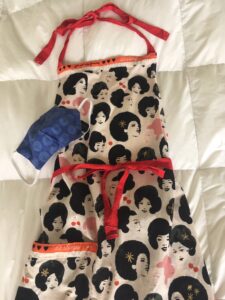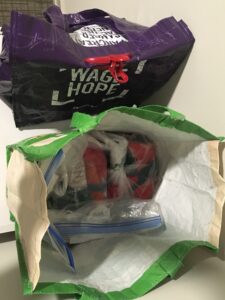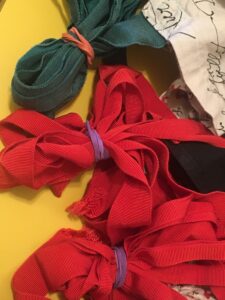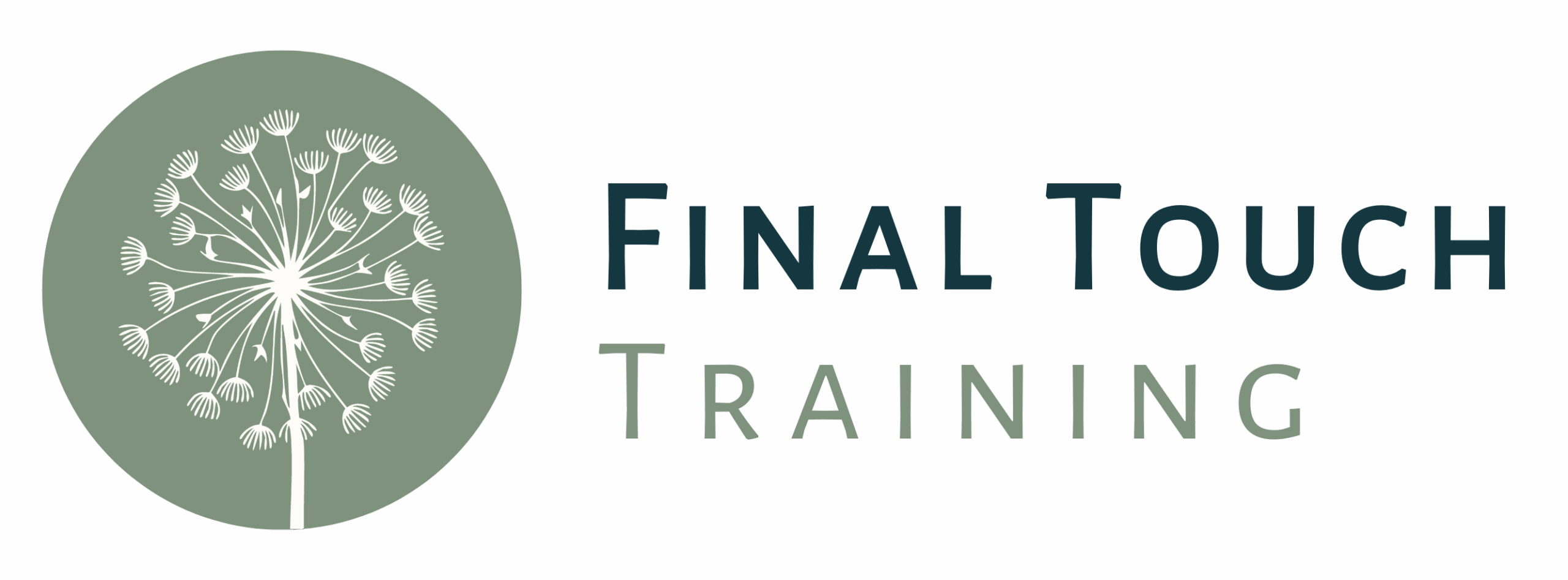GUIDELINES FOR MASSAGE THERAPY IN THE
HOSPICE INPATIENT ENVIRONMENT
May 23, 2020
Even as the nation and world continue to grapple with COVID-19, many businesses are reopening, including some sectors of the massage industry. The realities of asymptomatic transmission, insufficient testing, and scarcity of personal protective equipment for front line healthcare workers mean that every choice we make has a degree of risk. The risks vary, depending on a number of variables, including geographic prevalence of the virus. The setting in which massage is practiced is also a primary factor.
The following guidelines were created by Final Touch Training in collaboration with hospice team members working in a freestanding 24-bed hospice inpatient facility (the IPU). These measures are intended to mitigate risk of COVID-19 transmission in the specific, controlled environment of the IPU, based on what is known about the virus at this time.
The inpatient unit was considered an ideal setting in which to field-test these measures, due to the fact that the center is small and contained. The environment is controlled, with screening at entry, housekeeping support, and sanitizing materials widely available. Massage therapists operating at the IPU are already accustomed to standard precautions for infectious disease control (MRSA, VRE, C-Diff and others).
The goal of IPU care is to stabilize terminal patients for discharge to routine home care or to provide support for a peaceful death at the unit; most often, it is the latter. The IPU does not accept patients who are known to have or suspected of having COVID-19. These patients are referred to area hospitals that are better equipped to care for them.
Our guidelines, based on recommendations from the AMTA, ABMP, CDC, OSHA and CMS, were initiated at the unit on April 23rd, 2020. The massage therapy program is a well-established component of the comfort measures provided to our patients, considered as integral to the care plan as spiritual support, bathing, oral hygiene and clinical management of end-of-life symptoms. As such, massage therapy services have been universally supported by medical and administrative leadership at the IPU.
While we cannot predict whether the guidelines might have merit for other inpatient settings, we are sharing them in the interest of transparency and the hope of conversation with others who might be engaged in comparable endeavors. We will evaluate and refine this document as additional information comes to light.
Summary of Modifications for Massage Therapy in the Hospice Inpatient Unit
- Safety measures were designed to meet or exceed standards for nursing care, including the use of gloves, face masks and hand hygiene. The massage therapy protocol was approved by the medical director at the IPU.
- Hospice defines the “unit of care” as patient and chosen family who are often present during the patient’s IPU stay. This increases the number of exposures that may occur during a single massage encounter.
- Massage therapists in inpatient hospice care will need to focus on what is carried into and out of the patient’s space, avoiding contamination of carried supplies and personal items.
- Hospice clients are not candidates for face masks due to the symptomatic nature of end-stage disease, which often includes shortness of breath, nausea and vomiting, pain, and impaired ability to remove a mask without assistance.
- Due to the possibility of asymptomatic presentation, therapists must operate with an assumption that patients, visitors and they themselves may be positive for the virus. Standard airborne and contact precautions will therefore be followed at all times.
Our Guidelines for the Hospice Inpatient Environment
Screening Protocol
Massage therapists and other personnel are screened daily for fever as they enter the inpatient center. Personnel are required to report symptoms consistent with COVID-19, exposures to people who have tested positive or are presumed to be positive for the virus, travel on mass transit or to endemic areas, and work inside other group facilities. A temperature of 100 degrees is the cut-off for reporting to work. Personnel with known exposures or high-risk travel are required to self-quarantine for 14 days.
Patients who arrive at the unit from a private home are screened using the same parameters above; those having symptoms or suspected exposures are tested prior to IPU admission. Patients arriving from hospitals and other facilities (independent living, assisted living or skilled nursing homes) must have two negative tests. Our inpatient unit is not accepting patients who test positive. Many of our patients have fever and/or shortness of breath due to end-stage disease; these symptoms are therefore not used to disqualify a patient for services, including massage. However, patients who are coughing or sneezing are not considered appropriate for massage due to risk of airborne transmission. Ideal patients for massage therapy referral are those who are experiencing anxiety or pain which often respond favorably to gentle massage. In order to minimize the intake process at bedside, information regarding the patient is acquired by the therapist via electronic record prior to initiating contact. Physical distancing from other staff is exercised to the fullest extent possible during the referral process. As stated previously, hospice patients should not be expected to use a face mask.
Family/Caregivers/Visitors are currently allowed at our inpatient unit but restricted to two per patient at this time. All IPU visitors are screened identically to personnel (see first paragraph under screening). Visitors are required to wear face masks in common areas but do not always wear their masks while inside the patient’s room. Physical distancing from visitors is practiced to the fullest extent possible, before, during and after the massage session. This is accomplished by asking visitors to wear a mask while care staff are in the room, offering to provide the session at a later time while visitors are not present, or maintaining a minimum of six feet of distance from visitors during the session.
Clothing/PPE
In general, hair should be secured away from the face. Fingernails should be short and clean. Hands and wrists should be free of jewelry. Shoes should be close-toed. Sleeves should be short, or rolled to above the elbow.
Face masks will be worn by the therapist, a clean mask for each patient that the  therapist will see during the day. To protect the availability of PPE, masks may be homemade, of the safest variety available to the therapist (good fit with several layers of fabric, including a removable filter if possible). Mask will be placed and adjusted with clean hands prior to entering the patient’s room.
therapist will see during the day. To protect the availability of PPE, masks may be homemade, of the safest variety available to the therapist (good fit with several layers of fabric, including a removable filter if possible). Mask will be placed and adjusted with clean hands prior to entering the patient’s room.
An apron is recommended, one per patient that the therapist will see over the course of the day, to be worn by the therapist. Aprons may be handmade or purchased online from restaurant supply companies. At minimum, aprons should have one pocket; aprons can be purchased with a pocket, or a pocket can be added to a purchased apron with minimal sewing required. In lieu of an apron, the therapist may choose a change of shirt and pants between clients. A button-down shirt style is recommended to avoid contamination of the face during removal. Per Joint Commission regulations, a visible name badge must be worn by all hospice employees. The badge should be secured to an area of clothing that will not be removed or touched during removal of a contaminated apron or shirt; if this is not possible, the badge will need to be wiped with disinfectant between patients.
Gloves will be donned once the therapist is inside the patient’s room.
Supplies
Single-serve lotion containers will be utilized to prevent contamination of a lotion bottle or holster that is carried between clients. We have found that a 1-ounce “to go” container with a lid (available from restaurant supply companies) is adequate for one to two sessions of partial-body massage. The container will be discarded if all of the lotion is utilized in the session, or left behind with the patient or family if lotion is not completely utilized. To minimize risk of contamination, nothing else will be carried into the patient’s room: no cell phones, no reading glasses, no paper, pens or other extraneous items.
The therapist will need two large disposable or reusable grocery-style bags with flat bottom and handles, to serve as portable containers for storage and transport of PPE. These bags should be of different colors or clearly labeled, since one will serve as storage for clean PPE, and the other will store contaminated PPE. These bags should be constructed of a material that can be washed or disposed of at the end of every work day. A spring-loaded clip can be used to close and protect the contents of each bag during the work day. Clean PPE (masks, aprons and lotion containers) can be doubled bagged, allowing removal of clean supplies prior to washing the exterior bag at home.


Arrival Guidelines
Hands will be washed thoroughly up to the elbows per WHO Guidelines before donning a clean apron and face mask. Minimal supplies necessary to conduct the session should be placed in apron pocket. These include:
- Individual lotion container with preferred lubricant
- Gloves
- Paper towel to exit the room
An additional paper towel or the therapist’s unclothed elbow or forearm may be used to enter the room if the patient’s door is closed.
Session Guidelines
Remember that the therapist’s use of a face mask protects others, but the therapist is not protected unless others are also wearing masks. Many inpatient environments including ours currently require that visitors use masks, but patients will likely be unable to do so. Measures for as much social distancing as possible are therefore recommended.
Upon entering the patient’s room with clean hands, clean shirt or apron, and clean mask in place, the following guidelines are used at our inpatient unit.
- Sitting or standing near the foot or side of the patient’s bed (opposite visitors) to greet the patient and others in the room. No hugs or handshakes. Gestures of warmth and connection might include eye contact, placing a hand over the heart, a slight bowing of the head, and/or hands in prayer or Namaste position.
- We are currently offering foot massage rather than a full-body massage which requires greater exposure for both therapist and patient; between the therapist’s arms and the length of the patient’s body, there can be up to six feet of distance. Foot massage has been documented in the literature to provide meaningful relief for end-of-life pain, nausea, and anxiety (Grealish, Cancer Nursing, 2000; Billhult, Cancer Nursing, 2001), and has been well received by our patients at the unit.
- If visitors are present and not wearing masks, and/or unable or unwilling to practice physical distancing, the therapist may request to return at a time when visitors are not present (while visitors get lunch, for example).
- The therapist will avoid unnecessary touching of environmental surfaces (light switches, tray tables and door handles).
- The individual lotion container and gloves should be removed from the therapist’s pocket before touching the patient or any other surface. This ensures only clean hands are used to access the therapist’s pocket.
- Gloves should be donned before touching the patient or any other surface.
- Once gloves are donned, the therapist may adjust bed height for comfort.
- Therapists will avoid touching their faces, including eyes, nose, mouth and face mask, before, during and after the session.
Departure Guidelines
At the conclusion of the session, our therapists are following these guidelines:
- After returning the patient’s bed to a low, locked position, removal of gloves according to CDC protocol, avoiding contamination of hands. Dispose of gloves inside the patient’s room.
- Once gloves are removed, therapist will use hand sanitizer from dispenser in patient’s room prior to exiting the room.
- Therapist will use clean paper towel from apron pocket to touch doorknob to exit patient’s room. Discard paper towel in nearest trash receptacle, likely at nurses’ station. While at nurses’ station, therapist uses hand sanitizer again, obtaining additional paper towel(s) if needed to proceed to location with clean/contaminated PPE storage bags.
- Therapist removes “clip” on contaminated PPE bag with clean hands.
- Therapist removes face mask touching ear or head band rather than contaminated surface, folds mask with contaminated surface toward the inside, and places mask (if using a cloth one) inside bag for contaminated PPE storage for later transport home.
- Therapist removes apron, folding contaminated surfaces toward the inside. Therapist places folded apron in bag for contaminated storage bag for later transport.
- Therapist washes hands thoroughly up to the elbows before donning fresh mask and apron for next patient. Clips replaced to both bags and a brief note on previous encounter can be made at this time for later charting.
- Only clean hands should be used throughout the day to access the therapist’s personal items, such as cell phones, reading glasses, pens, paper, lunch, etc.
End-of-Shift Guidelines
Our therapists are currently charting at home or in an area of the IPU where social distancing can be practiced. The following additional guidelines are currently practiced at our inpatient unit upon completion of the therapist’s work day. Preparation for this end-of-shift routine requires the following be placed in the trunk of the therapist’s car: hand sanitizer and/or wipes, an empty plastic bag, a second plastic bag or bin, and a pair of slip-on shoes or slippers.
- Remove contaminated shoes prior to driving home and place them in the plastic bag. These shoes, dedicated for IPU use, will remain in the therapist’s car.
- Contaminated shoes are replaced with slip-ons (flip flops, slippers or other preference).
- Other items which may have been contaminated during the course of the work day are placed in plastic bag or bin and transported home to be sanitized with spray or wipes. These may include name badge, cell phone, work computer, reading glasses, water bottle and any other items accessed during the work day.
- Take care not to place contaminated items in the back seat of car if back seat is used by children, other passengers or pets.
- Before driving home, wipe down hands.
- After arriving home, wipe down steering wheel, gear stick, door handles, radio buttons, seat belt, and seat of car where contaminated items may have rested.
- Thorough hand washing with soap and water.
- Removal of clothing to be placed in normal wash cycle, along with or separately from contaminated aprons, cloth masks and clean/contaminated PPE storage bags.
- Wash hands or shower after touching contaminated laundry and supplies, nail brush recommended.
TIP: In order to prevent apron ties from becoming tangled while machine washing and drying, the ties can be bundled with rubber bands.

Self-Care for the Therapist
The measures described above require time, energy, commitment, mental focus, and emotional stamina from the therapist, operating in a world shaken by this crisis. Massage therapists in hospice care are accustomed to bearing witness to suffering, both the suffering of dying patients, and the suffering of the people who love them. The COVID-19 pandemic complicates the dying process, adding additional stress and grief. Massage therapists, like everyone else, are coping with their own losses, fears and life disruptions.
In recognition of these realities, therapists at the IPU are dedicated to the following self-care practices:
- Working to adjust expectations regarding the number of massages they are able to provide in a day’s time, working more slowly and more methodically.
- Not working excess hours.
- Getting adequate rest and nutrition.
- Maintaining safe practices in terms of travel and limited contact with others; staff at our IPU have contracted to comply with these measures.
- Mindful participation in enjoyable activities while not working.
Our administration has provided lunches and other gestures of appreciation for personnel involved in direct patient care. Therapists and the other hospice team members have benefitted from this caring, supportive environment. More than ever before, we are aware of our interdependent well-being. Maintaining our own good health is paramount to protecting the health of those we care for and hold dear.
Future Goals for Massage Therapy at the Hospice Inpatient Unit
Goals for the future will involve the concept of slowly “inching forward,” in the absence of unwanted outcomes, and as global COVID-19 control measures bear fruit.
- As our protocol becomes well established, we plan to return to offering aromatherapy, as a complement to massage or a stand-alone therapy. Aromatherapy will be introduced as an individual dose via personal inhaler, patch, or drops of essential oil on a tissue or cotton ball.
- Massage for the upper body (in supine, semi-Fowler’s or side-lying position) will resume when evidence suggests it is safe for all concerned. Of note, our nurses and nurse aides have continued to engage in close personal contact while providing comfort care to our IPU patients. None of these staff members have tested positive to date.
- The inpatient population represents just under 10% of our total hospice census. The majority of our patients reside at home, in private domiciles or group homes (independent living, assisted living or skilled nursing facility). At some point in the future, we look forward to resuming massage therapy in these home environments. At the time of this writing, we have had no positive COVID-19 cases among employees from the home team. If this remains the case, it bodes well for our massage therapists to follow protocols used by our nurses and nurse aides who are providing care while maintaining their health and the health of their patients.

